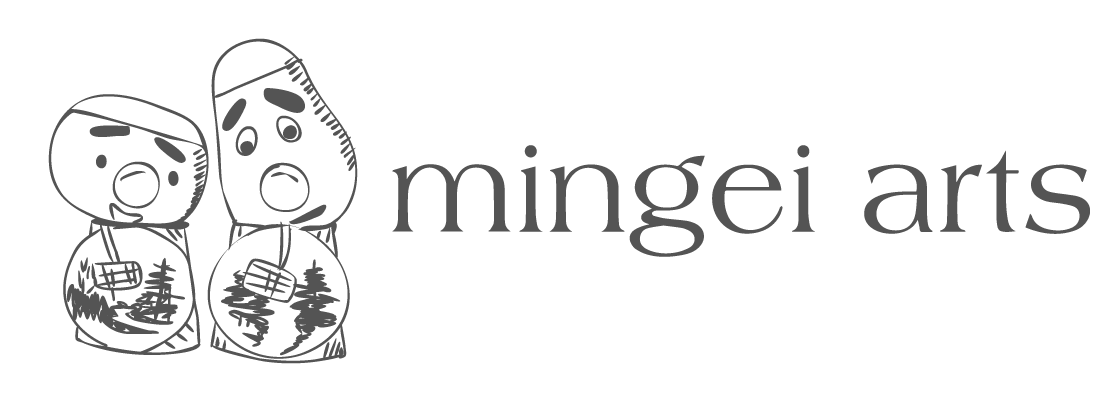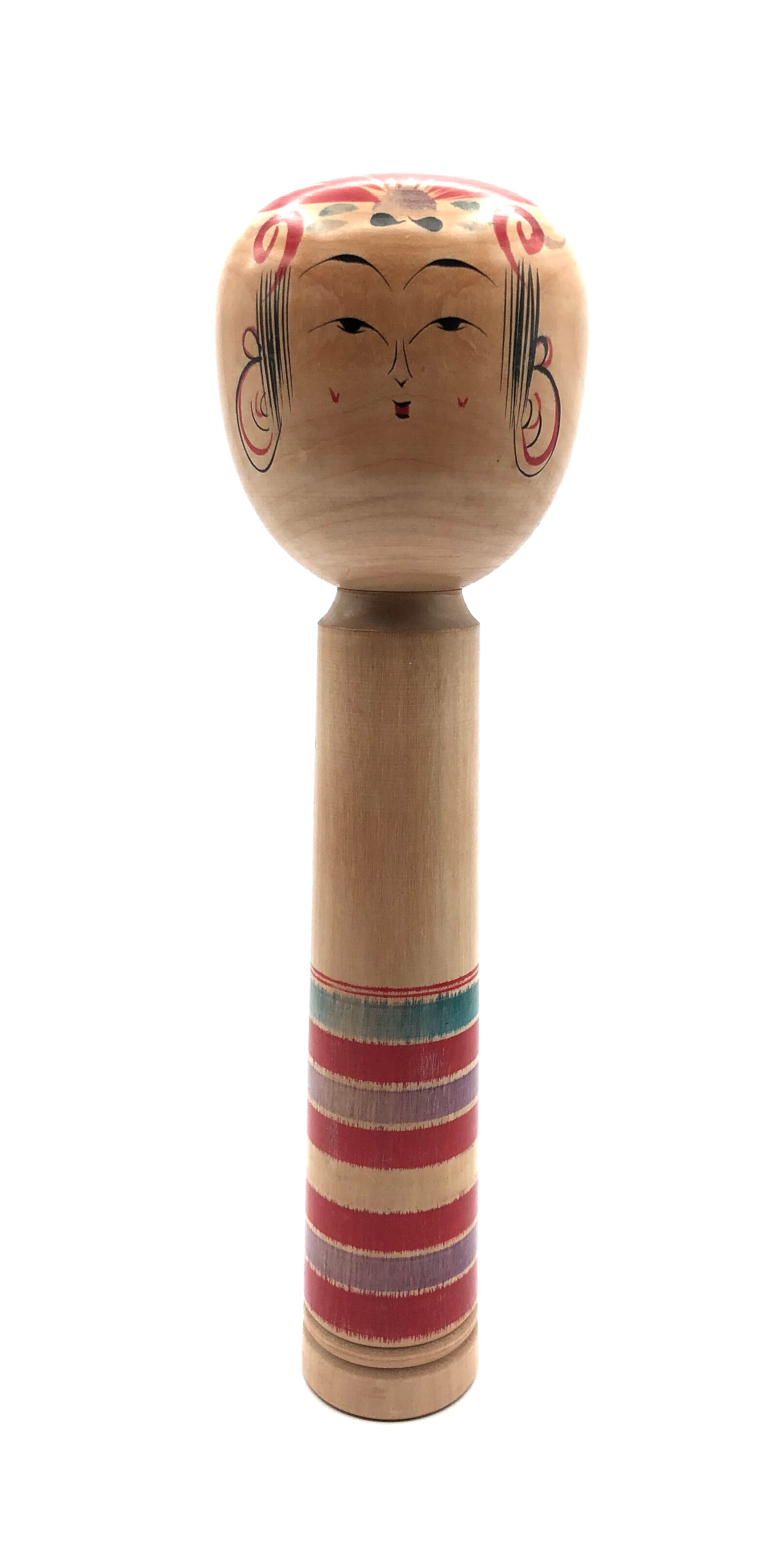
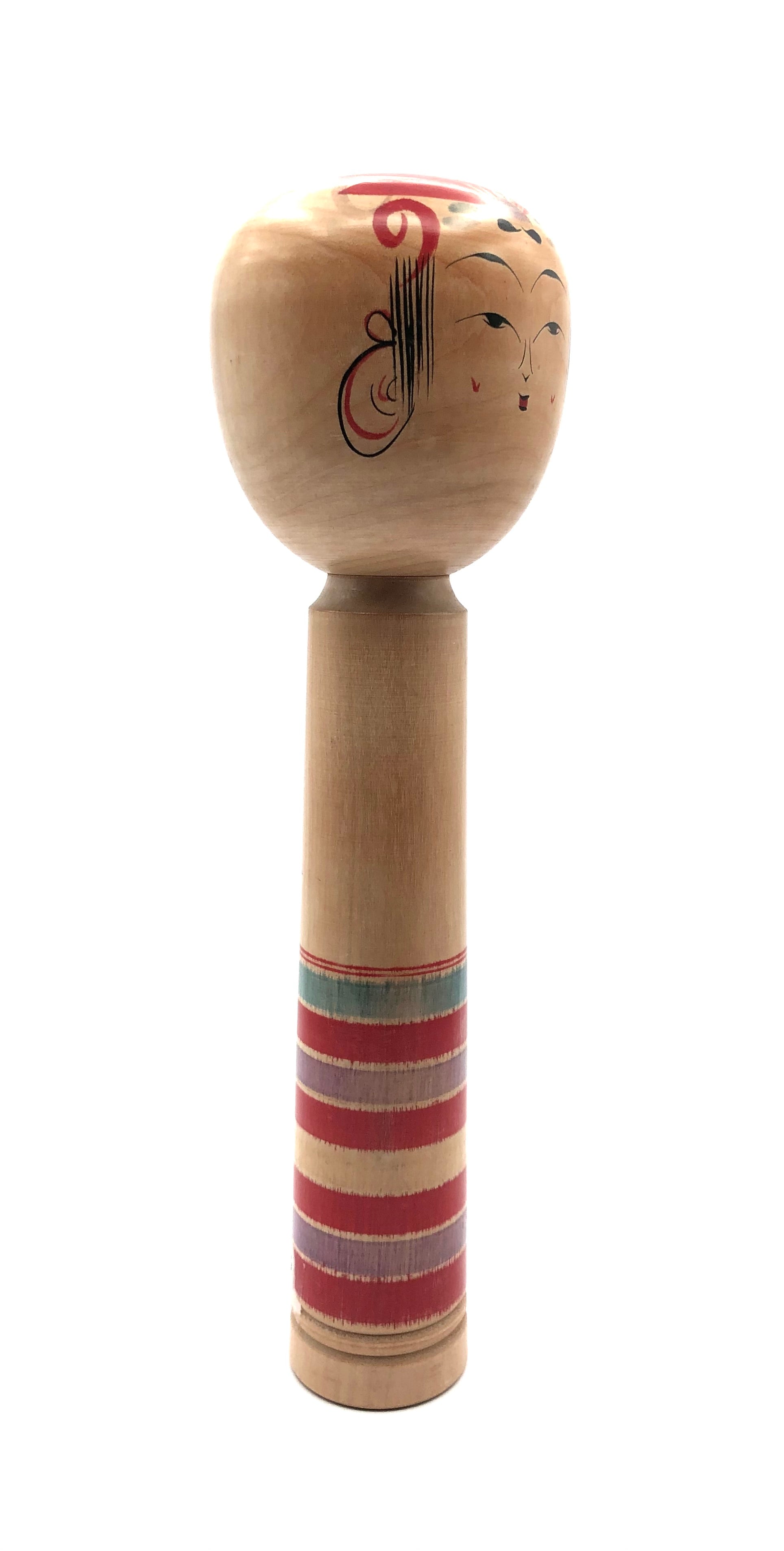
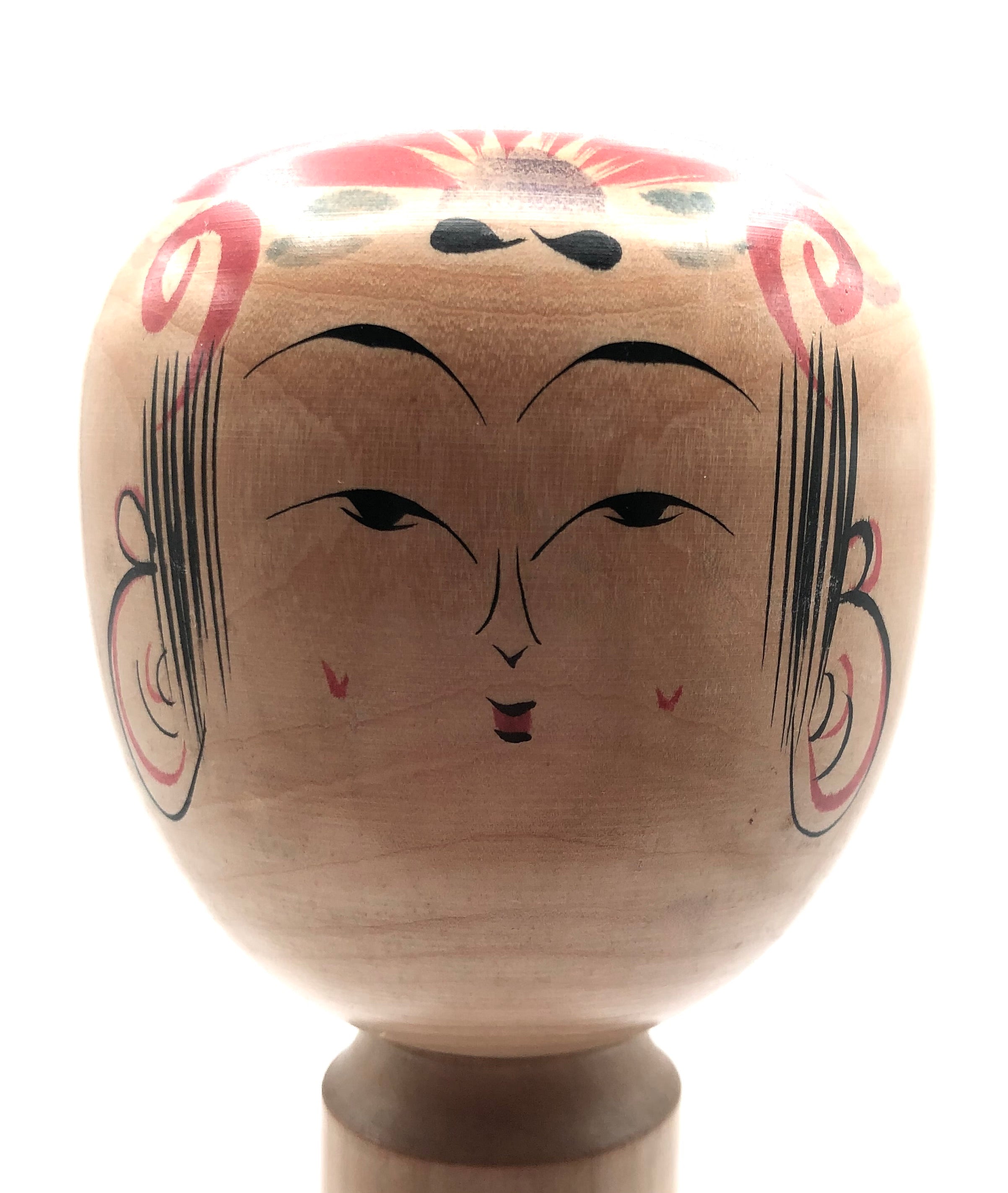
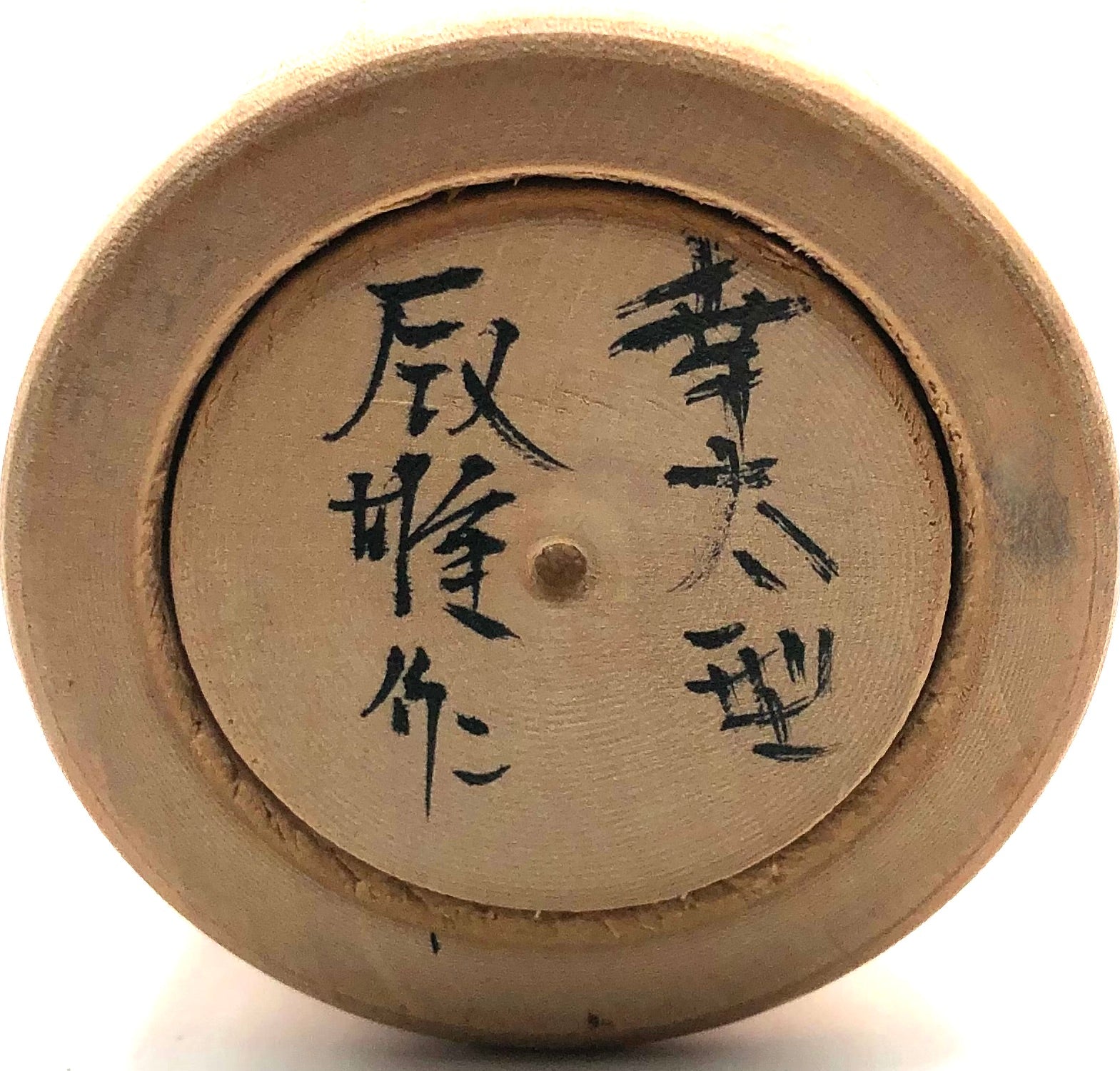
Vintage Japanese Yajirou, Bodhidharma Kokeshi “Rattler” by Sato Tatsuo (1928-)
Dimensions: 12-0”h
In Japan, nature, religion, and society are deeply intertwined. Nowhere is this more evident than in the mind of the woodworkers and lathe-turners, whose philosophical and spiritual beliefs are at the heart of their craft. Japanese Folk Art has long been admired for its high craft, precision, and simplicity. The Japanese believe in the Shinto philosophy, viewing trees as divine, and a means by which the gods descended to earth. Later, Buddhism taught that Buddha attained enlightenment in the forest, beneath an ancient tree. Hence the basis for the making of a Buddha Kokeshi.
This VERY unusual Kokeshi entitled: Mezameta momo | The Awakened is made by a prize-winning woodworker who studied under Yajirou Kokeshi Master Sato, Imasaburo. The RARENESS of this doll and the most recognizable feature of this Kokeshi is that it is a “Rattler”. Its large head is hollow and filled with rice, (gara iri), which creates a gentle sound when shaken. As part of Shinto music, making rhythmic sounds such as rattles, are believed to purify the sacred space, and facilitate the presence of the divine during ceremonies and festivals, and is part of the indigenous religion of Japan.
The beautiful graphics on the face of the doll are intriguing and meant to symbolize radiance. Here the artist utilized the basic Yajirou face, showing one eyelid with an open eye, a pick-shaped nose, and an indication of Buddha’s simplified cheeks, with a simple small red dot, and expressive mouth. We see an abstract chrysanthemum on the top of the head and two Urna marks on the forehead with graphic swirls of hair above the eyebrows, symbolizing radiance. Additionally, there are side hair fringes, and most importantly, the inclusion of Buddha’s large earlobes, which are long but void of any ornamentation, because he was supposed to have given up such luxuries. This Yajirou utilizes Rokoru moyo-style horizontal line-work of a veritable rainbow of colors at the bottom portion of the doll, with the center portion left empty of decoration. The doll is lathe-turned from one piece of Dogwood. The piece has the acknowledgment on the base in beautiful script and is signed by the artist.
To read more about this Family of Kokeshi makers, go to:https://mingeiarts.com/collections/yajirou-kei-family, for there is limited biographical information on the artist.
Condition: Superb outstanding, excellent, impressive, and beautiful. There are no chips, cracks, breaks, missing pieces, or restoration, and retains its original details and finish. The piece meets all the standards of the vintage collectible Traditional Yajirou Kokeshi.
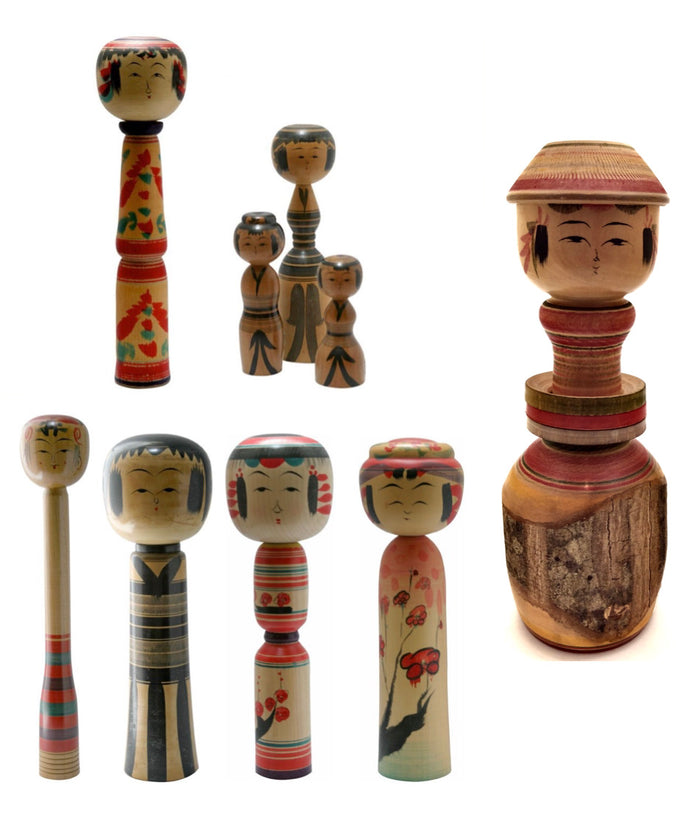
Japanese Traditional Kokeshi
Yajirou-Kei (Family)
Prefecture: Miyagi
Origin:
This strain of Kokeshi is said to have been an offshoot of the Tougatta strain and is far less refined. That eventually developed into a unique style that remains today. The creators of these dolls hail from the small farming village of Yajirou-machi near Kamasaki Onsen, in Miyagi Prefecture, once a farming village between two tall mountains. The Kiji-shi (woodworkers) divided their time between farming and woodcraft. Those who made kokeshi in their spare time sent their wives to the nearby Kamasaki Onsen to sell their work to tourist shops and onsens.
Collector's note – characteristics/painting style:
The majority of this style has distinct waists, or (kubire), where the body tapers inward, with a wider, flared base similar to a kimono, thus making them very stable. The upper body usually has a hand-painted collar with horizontal stripes encircling the body, as in the Rokoru-moyo style, and vertical stripes running below the waist to the base of the doll. However, Yajirou dolls can also be found with a series of chrysanthemum petals running down the front of the body, or a branch of plum blossoms, as the only decoration. Yajirou dolls are some of the most brightly painted of the traditional family group. Utilizing a veritable rainbow of colours, from the usual red and black to green, yellow, and even blue and purple, they are available in probably the widest range of shapes. Some also have a painted beret-like feature or a bun on their heads, similarly painted with a red center spot. Less common are Yajirou who have conical hats known as Suge-Gasa. Typically seen is one lid or double eyelids and a cat or pick-shaped nose. Yajirou kokeshi have been made from cherry wood, camellia, and maple, but the preferred wood is white dogwood, (Mizuki). And finally, both Yajirou and Tougutta dolls are sometimes created with loose rings circling the waists. Carved from the same wood as the body, which is a very meticulous method! This treatment is referred to as 'Yamiyo' style kokeshi.

Leading, Craftsmen:
Niiyama, Keimi, 1925, (Shirabu, Yamagata) - Master Niiyama, Keimi. No additional published information
Niiyama, Fukutaro, 1898-1965 - No additional published information
Niiyama Fukuo, 1922, (Yajiro Shironishi, Miyagi) - Master: Niiyama, Fukutaro. No additional published information
Niiyama, Hisaharu, 1942-2008 - No additional published information
Niiyama, Sanai (Master) - No additional published information
Oizumi, Kiyoni - No additional published information
Saito Masao, 1932, (Shiroishi, Miyagi) - Master: Sato, Tsugio. No additional published information
Sato Tatsuo, 1928-2009, (Yajiro Shiroishi , Miyagi) - Master: Sato, Imasaburo. No additional published information
Sato Yoshiaki, 1936, (Shiroishi Miyagi) - Master: Sato, Tatsuo. No additional published information
Sato, Koichi, 1936, (Shiroishi, Miyagi) - Master:Hamatsu, Heisaburo. No additional published information
Explore & Learn More about Yajirou-Kei (Family)